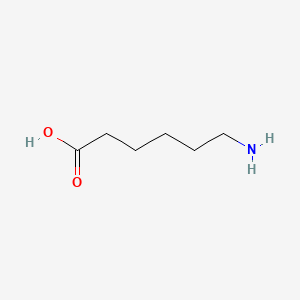| MeSH term | MeSH ID | Detail |
|---|---|---|
| Hemolysis | D006461 | 131 associated lipids |
| Uremia | D014511 | 33 associated lipids |
| Stomach Ulcer | D013276 | 75 associated lipids |
| Diabetes Mellitus | D003920 | 90 associated lipids |
| Sarcoma, Experimental | D012513 | 13 associated lipids |
| Adenocarcinoma | D000230 | 166 associated lipids |
| Lupus Erythematosus, Systemic | D008180 | 43 associated lipids |
| Hyperglycemia | D006943 | 21 associated lipids |
| Wounds and Injuries | D014947 | 20 associated lipids |
| Kidney Neoplasms | D007680 | 29 associated lipids |
6-aminohexanoic acid
6-aminohexanoic acid is a lipid of Fatty Acyls (FA) class. 6-aminohexanoic acid is associated with abnormalities such as Blood Clot, Myocardial Infarction, Cerebrovascular accident, Renal impairment and Scoliosis, unspecified. The involved functions are known as Fibrinolysis, Agent, Hemorrhage, plasminogen activation and inhibitors. 6-aminohexanoic acid often locates in Chest, Blood, Body tissue, peritoneal and Plasma membrane. The associated genes with 6-aminohexanoic acid are P4HTM gene, BSND gene, MTPN gene, NDUFS4 gene and Homologous Gene. The related lipids are Phosphatidylserines and Butyric Acid.
Cross Reference
Introduction
To understand associated biological information of 6-aminohexanoic acid, we collected biological information of abnormalities, associated pathways, cellular/molecular locations, biological functions, related genes/proteins, lipids and common seen animal/experimental models with organized paragraphs from literatures.
What diseases are associated with 6-aminohexanoic acid?
6-aminohexanoic acid is suspected in Cerebrovascular accident, Blood Clot, Myocardial Infarction, Renal impairment, Thromboembolism, Postoperative myocardial infarction and other diseases in descending order of the highest number of associated sentences.
Related references are mostly published in these journals:
| Disease | Cross reference | Weighted score | Related literature |
|---|
Possible diseases from mapped MeSH terms on references
We collected disease MeSH terms mapped to the references associated with 6-aminohexanoic acid
PubChem Associated disorders and diseases
What pathways are associated with 6-aminohexanoic acid
There are no associated biomedical information in the current reference collection.
PubChem Biomolecular Interactions and Pathways
Link to PubChem Biomolecular Interactions and PathwaysWhat cellular locations are associated with 6-aminohexanoic acid?
Visualization in cellular structure
Associated locations are in red color. Not associated locations are in black.
Related references are published most in these journals:
| Location | Cross reference | Weighted score | Related literatures |
|---|
What functions are associated with 6-aminohexanoic acid?
Related references are published most in these journals:
| Function | Cross reference | Weighted score | Related literatures |
|---|
What lipids are associated with 6-aminohexanoic acid?
Related references are published most in these journals:
| Lipid concept | Cross reference | Weighted score | Related literatures |
|---|
What genes are associated with 6-aminohexanoic acid?
Related references are published most in these journals:
| Gene | Cross reference | Weighted score | Related literatures |
|---|
What common seen animal models are associated with 6-aminohexanoic acid?
There are no associated biomedical information in the current reference collection.
NCBI Entrez Crosslinks
All references with 6-aminohexanoic acid
Download all related citations| Authors | Title | Published | Journal | PubMed Link |
|---|---|---|---|---|
| Lakhani A et al. | Intravesicular instillation of E-aminocaproic acid for patients with adenovirus-induced hemorrhagic cystitis. | 1999 | Bone Marrow Transplant. | pmid:10642819 |
| Miyamoto H and Okajima M | Allergic contact dermatitis from epsilon-aminocaproic acid. | 2000 | Contact Derm. | pmid:10644032 |
| Needleman HL et al. | The use of epsilon-aminocaproic acid for the management of hemophilia in dental and oral surgery patients. | 1976 | J Am Dent Assoc | pmid:1066390 |
| Laska S and Kletzin A | Improved purification of the membrane-bound hydrogenase-sulfur-reductase complex from thermophilic archaea using epsilon-aminocaproic acid-containing chromatography buffers. | 2000 | J. Chromatogr. B Biomed. Sci. Appl. | pmid:10681051 |
| Beyermann M et al. | A role for a helical connector between two receptor binding sites of a long-chain peptide hormone. | 2000 | J. Biol. Chem. | pmid:10681555 |
| Liu G et al. | Postoperative fibrinolysis diagnosed by thrombelastography. | 2000 | Anaesth Intensive Care | pmid:10701043 |
| Gans H | Pharmacological control of bleeding during cardiac surgery. | 2000 | Lancet | pmid:10703828 |
| Fless GM et al. | The relationship between the effect of lysine analogues and salt on the conformation of lipoprotein(a). | 2000 | Biochemistry | pmid:10704226 |
| Liang JF et al. | The potential mechanism for the effect of heparin on tissue plasminogen activator-mediated plasminogen activation. | 2000 | Thromb. Res. | pmid:10709911 |
| Sistino JJ and Richards C | The additive effects of antifibrinolytics: dangers in the OR. | 1999 | J Extra Corpor Technol | pmid:10724650 |
